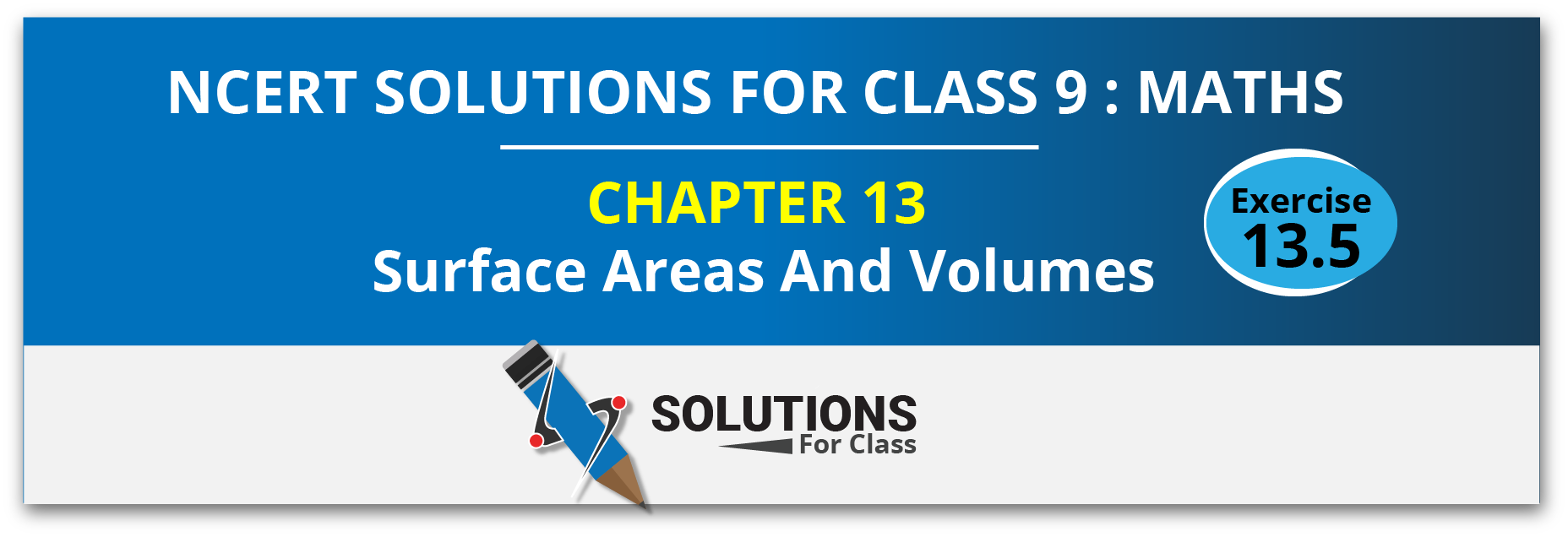NCERT Solution For Class 9, Maths, Chapter 13, Surface Areas And Volumes, Exercise 13.5 is based on volumes of cuboidal shapes. Exercise 13.5 class 9 maths chapter 13 helps students to clear all basics of maths related volumes. by putting simple formula, students can easily solve all the given problems.
Table of Contents
Toggle
Class 9, Maths, Chapter 13, Exercise 13.5 Solutions (Page no. 228)
Q.1. A matchbox measures 4 cm × 2.5 cm × 1.5 cm. What will be the volume of a packet containing 12 such boxes?
Ans: Here l = 4 cm, b = 2.5 cm and h = 1.5 cm.
∴ Volume of one matchbox = l x b x h cm3
= (4 x 2.5 x 1.5) cm3 = 15 cm3
∴ Volume of a packet containing 12 such boxes
= (12 x 15) cm3 = 180 cm3
Q.2. A cuboidal water tank is 6 m long, 5 m wide and 4.5 m deep. How many liters of water can it hold? (1 m3 = 1000 L)
Ans: Here l = 6 m, 6 = 5 m and h = 4.5 m
∴ Volume of the tank = I x b x h m3
= (6 x 5 x 4.5) m3= 135 m3
The tank can hold = 135 x 1000 litres [ 1 m3 = 1000 litre]
= 135000 litres of water.
Q.3. A cuboidal vessel is 10 m long and 8 m wide. How high must it be made to hold 380 cubic metres of a liquid?
Ans: Here, length = 10 in, breadth = 8 m and volume = 380 m3
Height =$\frac{Volume\,\,of\,\,cuboid}{Length\,\,\times \,\,Breadth}$
$=\left( \frac{380}{10\times 8} \right)m=4.75\,\,m$
Q.4. Find the cost of digging a cuboidal pit 8 m long, 6 m broad and 3 m deep at the rate of ₹30 per m3.
Ans: Here, l = 8 m, b = 6 m and h = 3 m
Volume of the pit = I x b x h m3
= (8 x 6 x 3) m3 = 1 4 4 m3
Rate of digging is ₹ 30 per m3
∴ Cost of digging the pit = ₹ (144 x 30) = ₹ 4320
Q.5. The capacity of a cuboidal tank is 50000 litres of water. Find the breadth of the tank, if its length and depth are respectively 2.5 m and 10 m.
Ans: Here, length = 2.5 m, depth = 10 m
and volume = 50000 litres
= $\left( 50000\times \frac{1}{1000} \right){{m}^{3}}$ [∵ 1 m3 = 1000 liters]
= 50 m3
Breadth =$\frac{Volume\,\,of\,\,cuboid}{Length\,\,\times \,\,Breadth}=\frac{50}{2.5\times 10}$= 2 m
Q.6. A village, having a population of 4000, requires 150 litres of water per head per day. It has a tank measuring 20 m × 15 m × 6 m. For how many days will the water of this tank last?
Ans: Here, l = 20 m, b = 15 m and h = 6 m.
Capacity of the tank = I x b x h m3
= (20 x 15 x 6) m3 = 1800 m3
Water requirement per person per day = 150 litres
Water required for 4000 person per day = (4000 x 150) liters
= $\left( \frac{40000\times 150}{1000} \right){{m}^{3}}=600\,\,{{m}^{3}}$
Number of days the water will last
= $\frac{Capacity\,\,of\,\,\tan k}{Total\,\,water\,\,required\,\,per\,\,day}=\frac{1800}{600}=30$
Thus, the water will last for 30 days.
Q.7. A godown measures 40 m × 25 m × 15 m. Find the maximum number of wooden crates each measuring 1.5 m × 1.25 m × 0.5 m that can be stored in the godown.
Ans: Volume of the godown = (60 x 25 x 10) m3 = 15000 m3
Volume of 1 crate = (1.5 x 1.25 x 0.5) m3 = 0.9375 m3
Number of crates that can be stored in the godown
= $\frac{Volume\,\,of\,\,the\,\,godown}{Volume\,\,of\,\,1\,\,crate}=\frac{15000}{0.9375}=16000$
Q.8. A solid cube of side 12 cm is cut into eight cubes of equal volume. What will be the side of the new cube? Also, find the ratio between their surface areas.
Ans: let V1 = Volume of the cube of edge 12 cm
= (12 × 12 × 12) cm3
And V2= volume of the cube cut out of the first one
= $\frac{1}{8}\times {{V}_{1}}$
= $\left( \frac{1}{8}\times 12\times 12\times 12 \right)c{{m}^{3}}$
= (6×6×6) cm3
∴ Side of the new cube = 6 cm
Ratio of their surface areas = $\frac{6{{(Side)}^{2}}}{6{{(Side)}^{2}}}=\frac{6\times 12\times 12}{6\times 6\times 6}=\frac{4}{1}$ i.e 4 : 1
Q.9. A river 3 m deep and 40 m wide is flowing at the rate of 2 km per hour. How much water will fall into the sea in a minute?
Ans: Since the water flows at the rate of 2 km per hour, the water from 2 km of river flows into the sea in one hour.
The volume of water flowing into the sea in one hour
= Volume of the cuboid
= (l × b × h) m3
= (2000 × 40 × 3) m3
∴ The volume of water flowing into the sea in one minute
= $\left( \frac{2000\times 40\times 3}{60} \right){{m}^{3}}$ = 4000 m3
NCERT Solutions For Class 9, Maths, Chapter 13, Surface Areas And Volumes (All Exercises)
- Class 9, Maths, Surface Areas And Volumes, Exercise 13.1
- Class 9, Maths, Surface Areas And Volumes, Exercise 13.2
- Class 9, Maths, Surface Areas And Volumes, Exercise 13.3
- Class 9, Maths, Surface Areas And Volumes, Exercise 13.4
- Class 9, Maths, Surface Areas And Volumes, Exercise 13.5
- Class 9, Maths, Surface Areas And Volumes, Exercise 13.6
- Class 9, Maths, Surface Areas And Volumes, Exercise 13.7
- Class 9, Maths, Surface Areas And Volumes, Exercise 13.8
- Class 9, Maths, Surface Areas And Volumes, Exercise 13.9

